BEO1105 Assignment: Understanding Supply, Demand, and Equilibrium
VerifiedAdded on 2023/06/10
|12
|1541
|207
Homework Assignment
AI Summary
This assignment delves into the principles of economics, focusing on market equilibrium and demand analysis. It addresses the relationship between price and quantity demanded, examining scenarios such as the impact of poor harvests on wine markets and the effects of changing wages on orange juice supply. The assignment also explores price elasticity of demand in the context of taxi services and analyzes a firm's profit-maximizing output level in a monopolistically competitive market. The solutions include graphical representations to support the explanations, providing a comprehensive understanding of the economic concepts. Desklib provides this assignment as a valuable resource for students seeking to enhance their knowledge of economics and improve their academic performance.
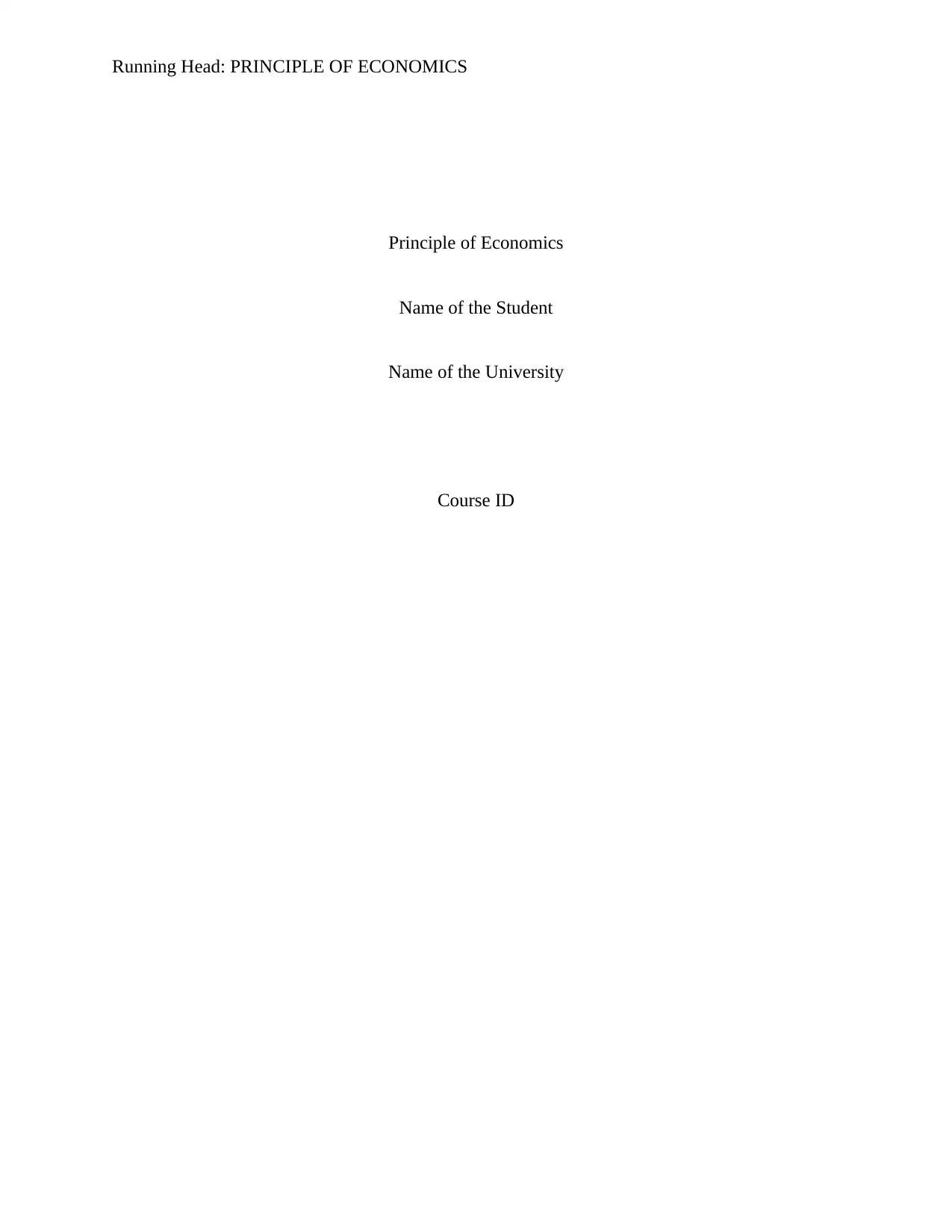
Running Head: PRINCIPLE OF ECONOMICS
Principle of Economics
Name of the Student
Name of the University
Course ID
Principle of Economics
Name of the Student
Name of the University
Course ID
Paraphrase This Document
Need a fresh take? Get an instant paraphrase of this document with our AI Paraphraser
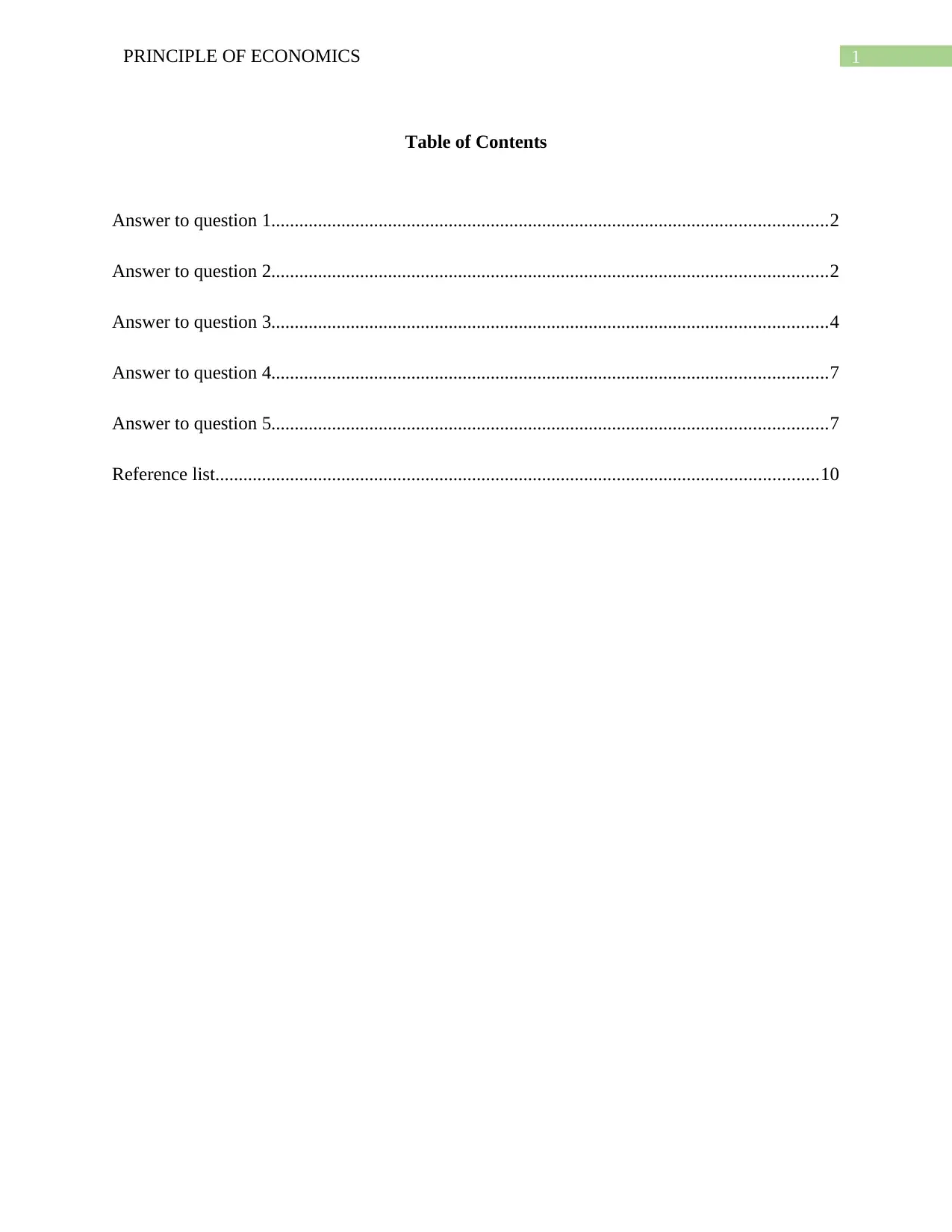
1PRINCIPLE OF ECONOMICS
Table of Contents
Answer to question 1.......................................................................................................................2
Answer to question 2.......................................................................................................................2
Answer to question 3.......................................................................................................................4
Answer to question 4.......................................................................................................................7
Answer to question 5.......................................................................................................................7
Reference list.................................................................................................................................10
Table of Contents
Answer to question 1.......................................................................................................................2
Answer to question 2.......................................................................................................................2
Answer to question 3.......................................................................................................................4
Answer to question 4.......................................................................................................................7
Answer to question 5.......................................................................................................................7
Reference list.................................................................................................................................10
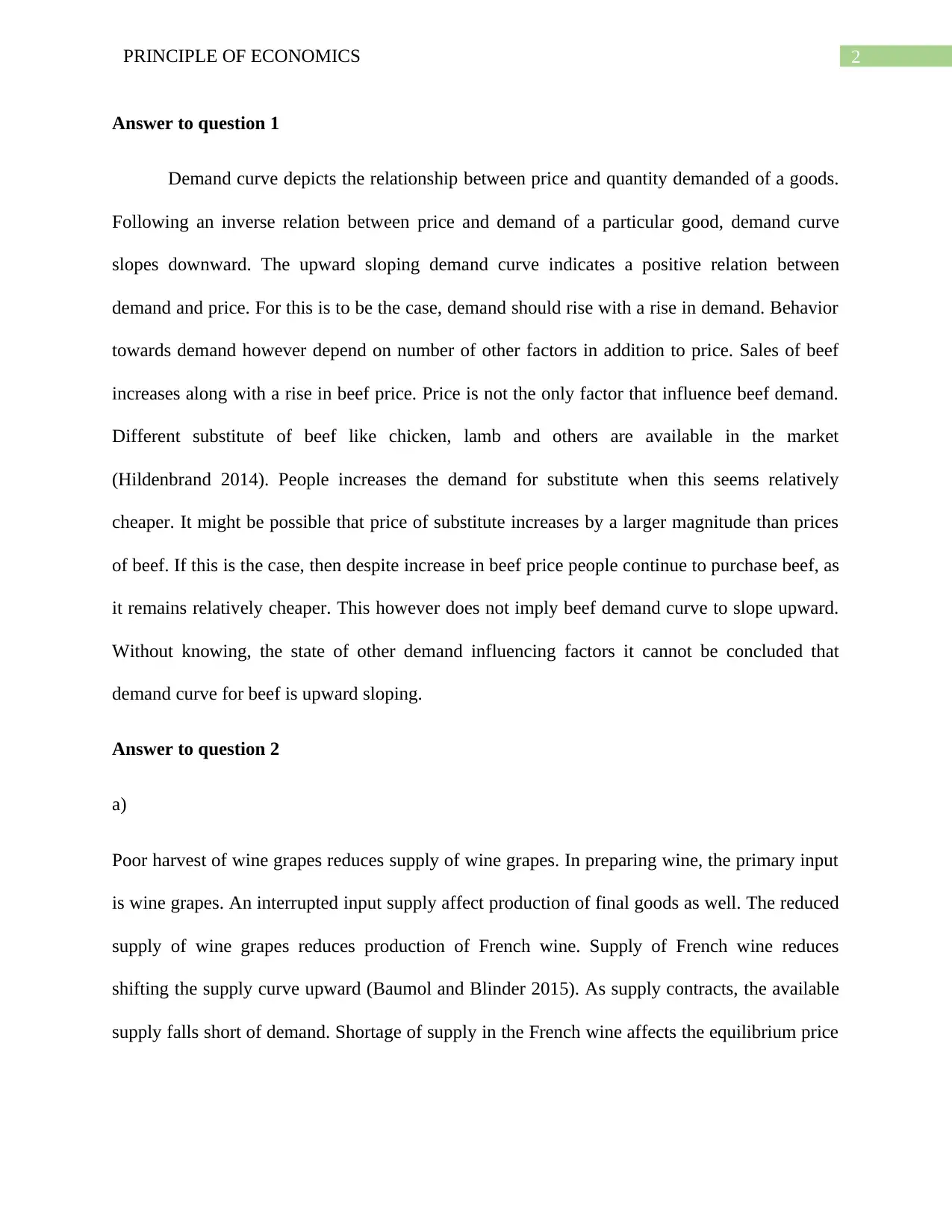
2PRINCIPLE OF ECONOMICS
Answer to question 1
Demand curve depicts the relationship between price and quantity demanded of a goods.
Following an inverse relation between price and demand of a particular good, demand curve
slopes downward. The upward sloping demand curve indicates a positive relation between
demand and price. For this is to be the case, demand should rise with a rise in demand. Behavior
towards demand however depend on number of other factors in addition to price. Sales of beef
increases along with a rise in beef price. Price is not the only factor that influence beef demand.
Different substitute of beef like chicken, lamb and others are available in the market
(Hildenbrand 2014). People increases the demand for substitute when this seems relatively
cheaper. It might be possible that price of substitute increases by a larger magnitude than prices
of beef. If this is the case, then despite increase in beef price people continue to purchase beef, as
it remains relatively cheaper. This however does not imply beef demand curve to slope upward.
Without knowing, the state of other demand influencing factors it cannot be concluded that
demand curve for beef is upward sloping.
Answer to question 2
a)
Poor harvest of wine grapes reduces supply of wine grapes. In preparing wine, the primary input
is wine grapes. An interrupted input supply affect production of final goods as well. The reduced
supply of wine grapes reduces production of French wine. Supply of French wine reduces
shifting the supply curve upward (Baumol and Blinder 2015). As supply contracts, the available
supply falls short of demand. Shortage of supply in the French wine affects the equilibrium price
Answer to question 1
Demand curve depicts the relationship between price and quantity demanded of a goods.
Following an inverse relation between price and demand of a particular good, demand curve
slopes downward. The upward sloping demand curve indicates a positive relation between
demand and price. For this is to be the case, demand should rise with a rise in demand. Behavior
towards demand however depend on number of other factors in addition to price. Sales of beef
increases along with a rise in beef price. Price is not the only factor that influence beef demand.
Different substitute of beef like chicken, lamb and others are available in the market
(Hildenbrand 2014). People increases the demand for substitute when this seems relatively
cheaper. It might be possible that price of substitute increases by a larger magnitude than prices
of beef. If this is the case, then despite increase in beef price people continue to purchase beef, as
it remains relatively cheaper. This however does not imply beef demand curve to slope upward.
Without knowing, the state of other demand influencing factors it cannot be concluded that
demand curve for beef is upward sloping.
Answer to question 2
a)
Poor harvest of wine grapes reduces supply of wine grapes. In preparing wine, the primary input
is wine grapes. An interrupted input supply affect production of final goods as well. The reduced
supply of wine grapes reduces production of French wine. Supply of French wine reduces
shifting the supply curve upward (Baumol and Blinder 2015). As supply contracts, the available
supply falls short of demand. Shortage of supply in the French wine affects the equilibrium price
⊘ This is a preview!⊘
Do you want full access?
Subscribe today to unlock all pages.

Trusted by 1+ million students worldwide
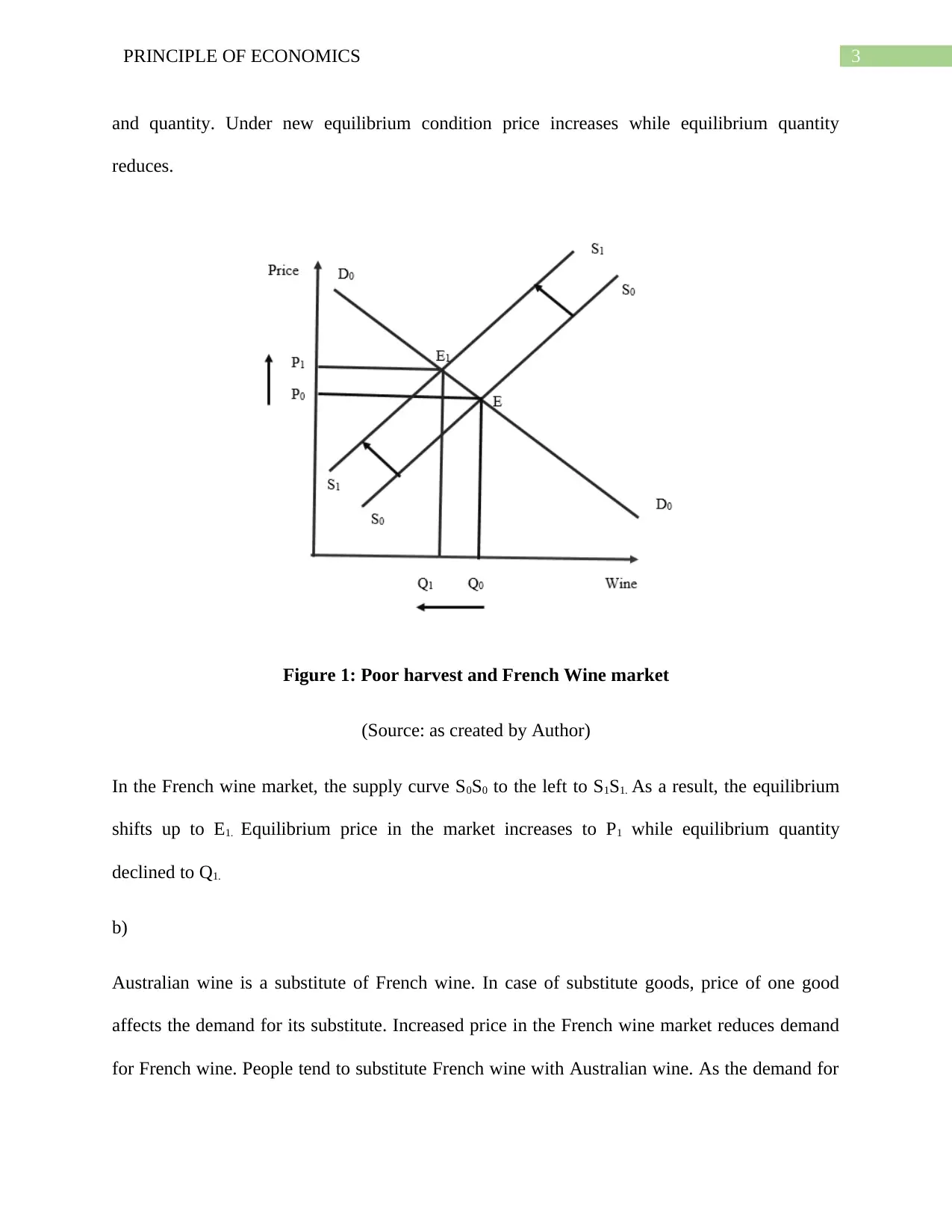
3PRINCIPLE OF ECONOMICS
and quantity. Under new equilibrium condition price increases while equilibrium quantity
reduces.
Figure 1: Poor harvest and French Wine market
(Source: as created by Author)
In the French wine market, the supply curve S0S0 to the left to S1S1. As a result, the equilibrium
shifts up to E1. Equilibrium price in the market increases to P1 while equilibrium quantity
declined to Q1.
b)
Australian wine is a substitute of French wine. In case of substitute goods, price of one good
affects the demand for its substitute. Increased price in the French wine market reduces demand
for French wine. People tend to substitute French wine with Australian wine. As the demand for
and quantity. Under new equilibrium condition price increases while equilibrium quantity
reduces.
Figure 1: Poor harvest and French Wine market
(Source: as created by Author)
In the French wine market, the supply curve S0S0 to the left to S1S1. As a result, the equilibrium
shifts up to E1. Equilibrium price in the market increases to P1 while equilibrium quantity
declined to Q1.
b)
Australian wine is a substitute of French wine. In case of substitute goods, price of one good
affects the demand for its substitute. Increased price in the French wine market reduces demand
for French wine. People tend to substitute French wine with Australian wine. As the demand for
Paraphrase This Document
Need a fresh take? Get an instant paraphrase of this document with our AI Paraphraser
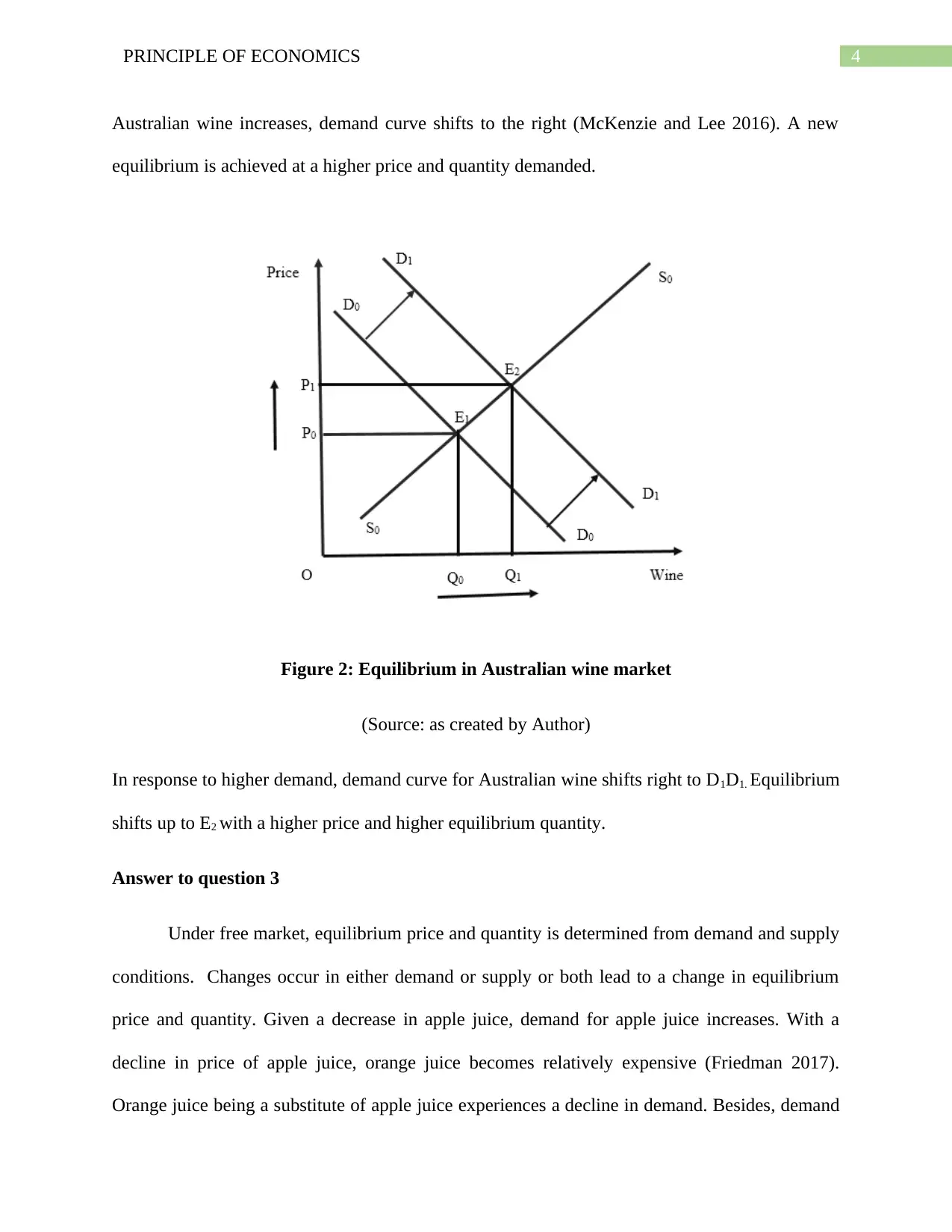
4PRINCIPLE OF ECONOMICS
Australian wine increases, demand curve shifts to the right (McKenzie and Lee 2016). A new
equilibrium is achieved at a higher price and quantity demanded.
Figure 2: Equilibrium in Australian wine market
(Source: as created by Author)
In response to higher demand, demand curve for Australian wine shifts right to D1D1. Equilibrium
shifts up to E2 with a higher price and higher equilibrium quantity.
Answer to question 3
Under free market, equilibrium price and quantity is determined from demand and supply
conditions. Changes occur in either demand or supply or both lead to a change in equilibrium
price and quantity. Given a decrease in apple juice, demand for apple juice increases. With a
decline in price of apple juice, orange juice becomes relatively expensive (Friedman 2017).
Orange juice being a substitute of apple juice experiences a decline in demand. Besides, demand
Australian wine increases, demand curve shifts to the right (McKenzie and Lee 2016). A new
equilibrium is achieved at a higher price and quantity demanded.
Figure 2: Equilibrium in Australian wine market
(Source: as created by Author)
In response to higher demand, demand curve for Australian wine shifts right to D1D1. Equilibrium
shifts up to E2 with a higher price and higher equilibrium quantity.
Answer to question 3
Under free market, equilibrium price and quantity is determined from demand and supply
conditions. Changes occur in either demand or supply or both lead to a change in equilibrium
price and quantity. Given a decrease in apple juice, demand for apple juice increases. With a
decline in price of apple juice, orange juice becomes relatively expensive (Friedman 2017).
Orange juice being a substitute of apple juice experiences a decline in demand. Besides, demand
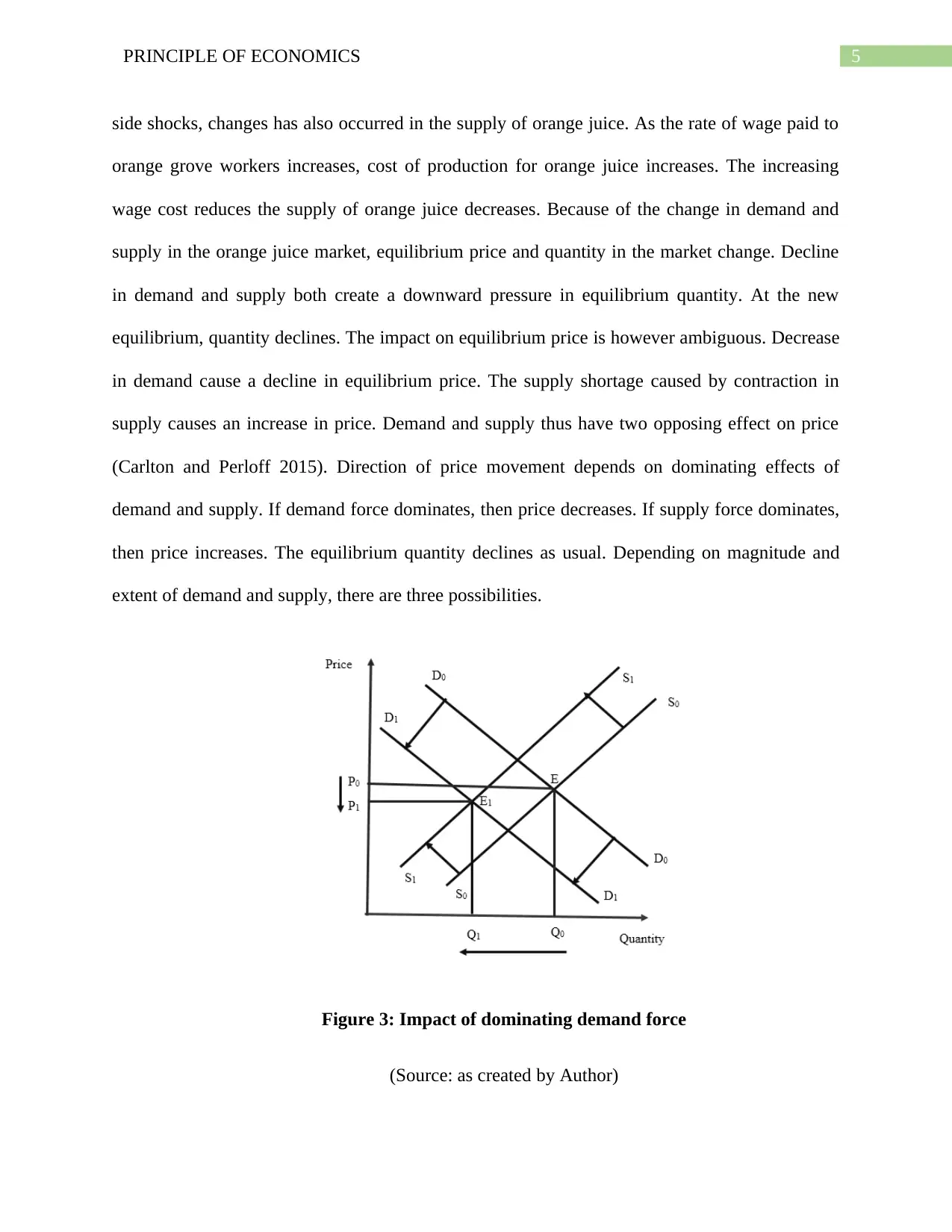
5PRINCIPLE OF ECONOMICS
side shocks, changes has also occurred in the supply of orange juice. As the rate of wage paid to
orange grove workers increases, cost of production for orange juice increases. The increasing
wage cost reduces the supply of orange juice decreases. Because of the change in demand and
supply in the orange juice market, equilibrium price and quantity in the market change. Decline
in demand and supply both create a downward pressure in equilibrium quantity. At the new
equilibrium, quantity declines. The impact on equilibrium price is however ambiguous. Decrease
in demand cause a decline in equilibrium price. The supply shortage caused by contraction in
supply causes an increase in price. Demand and supply thus have two opposing effect on price
(Carlton and Perloff 2015). Direction of price movement depends on dominating effects of
demand and supply. If demand force dominates, then price decreases. If supply force dominates,
then price increases. The equilibrium quantity declines as usual. Depending on magnitude and
extent of demand and supply, there are three possibilities.
Figure 3: Impact of dominating demand force
(Source: as created by Author)
side shocks, changes has also occurred in the supply of orange juice. As the rate of wage paid to
orange grove workers increases, cost of production for orange juice increases. The increasing
wage cost reduces the supply of orange juice decreases. Because of the change in demand and
supply in the orange juice market, equilibrium price and quantity in the market change. Decline
in demand and supply both create a downward pressure in equilibrium quantity. At the new
equilibrium, quantity declines. The impact on equilibrium price is however ambiguous. Decrease
in demand cause a decline in equilibrium price. The supply shortage caused by contraction in
supply causes an increase in price. Demand and supply thus have two opposing effect on price
(Carlton and Perloff 2015). Direction of price movement depends on dominating effects of
demand and supply. If demand force dominates, then price decreases. If supply force dominates,
then price increases. The equilibrium quantity declines as usual. Depending on magnitude and
extent of demand and supply, there are three possibilities.
Figure 3: Impact of dominating demand force
(Source: as created by Author)
⊘ This is a preview!⊘
Do you want full access?
Subscribe today to unlock all pages.

Trusted by 1+ million students worldwide
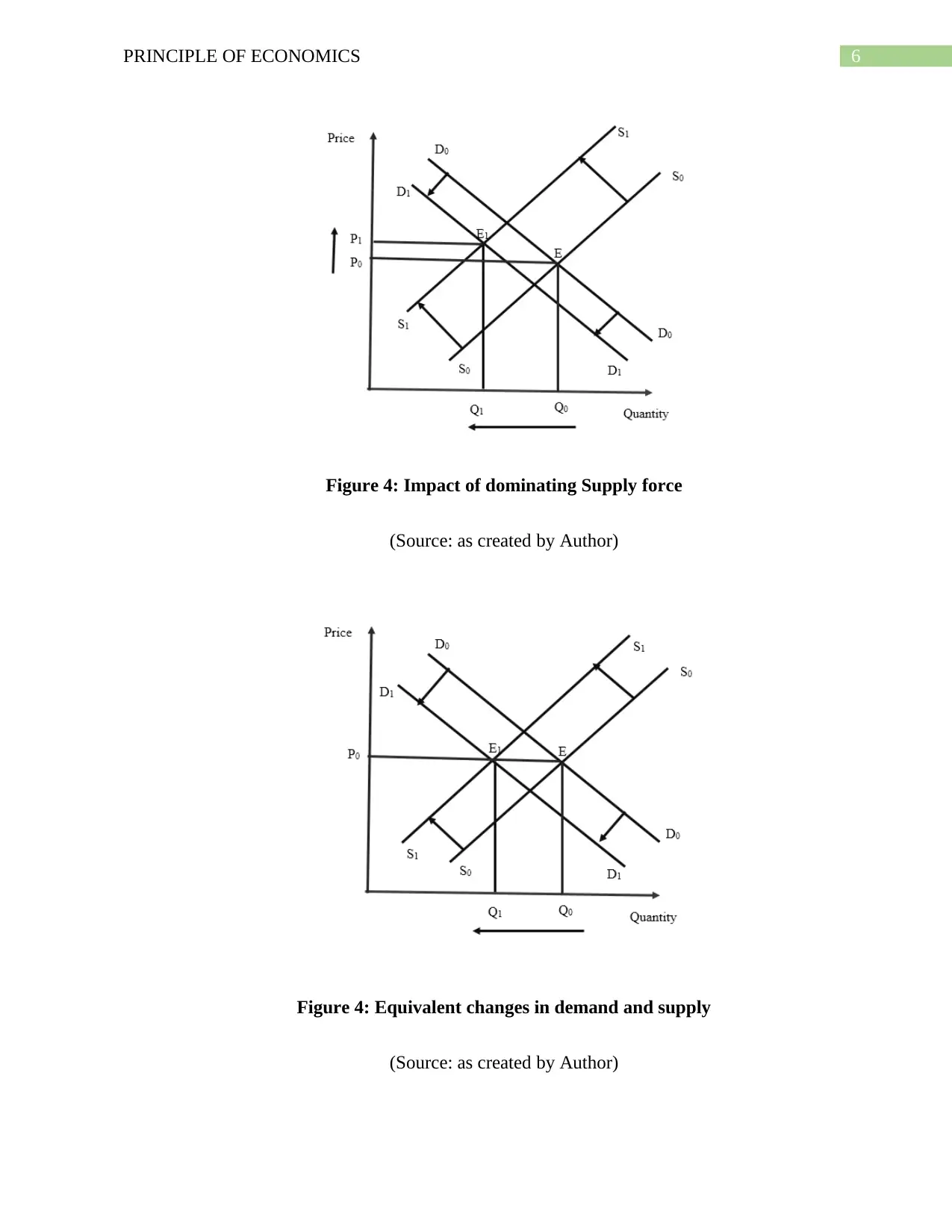
6PRINCIPLE OF ECONOMICS
Figure 4: Impact of dominating Supply force
(Source: as created by Author)
Figure 4: Equivalent changes in demand and supply
(Source: as created by Author)
Figure 4: Impact of dominating Supply force
(Source: as created by Author)
Figure 4: Equivalent changes in demand and supply
(Source: as created by Author)
Paraphrase This Document
Need a fresh take? Get an instant paraphrase of this document with our AI Paraphraser
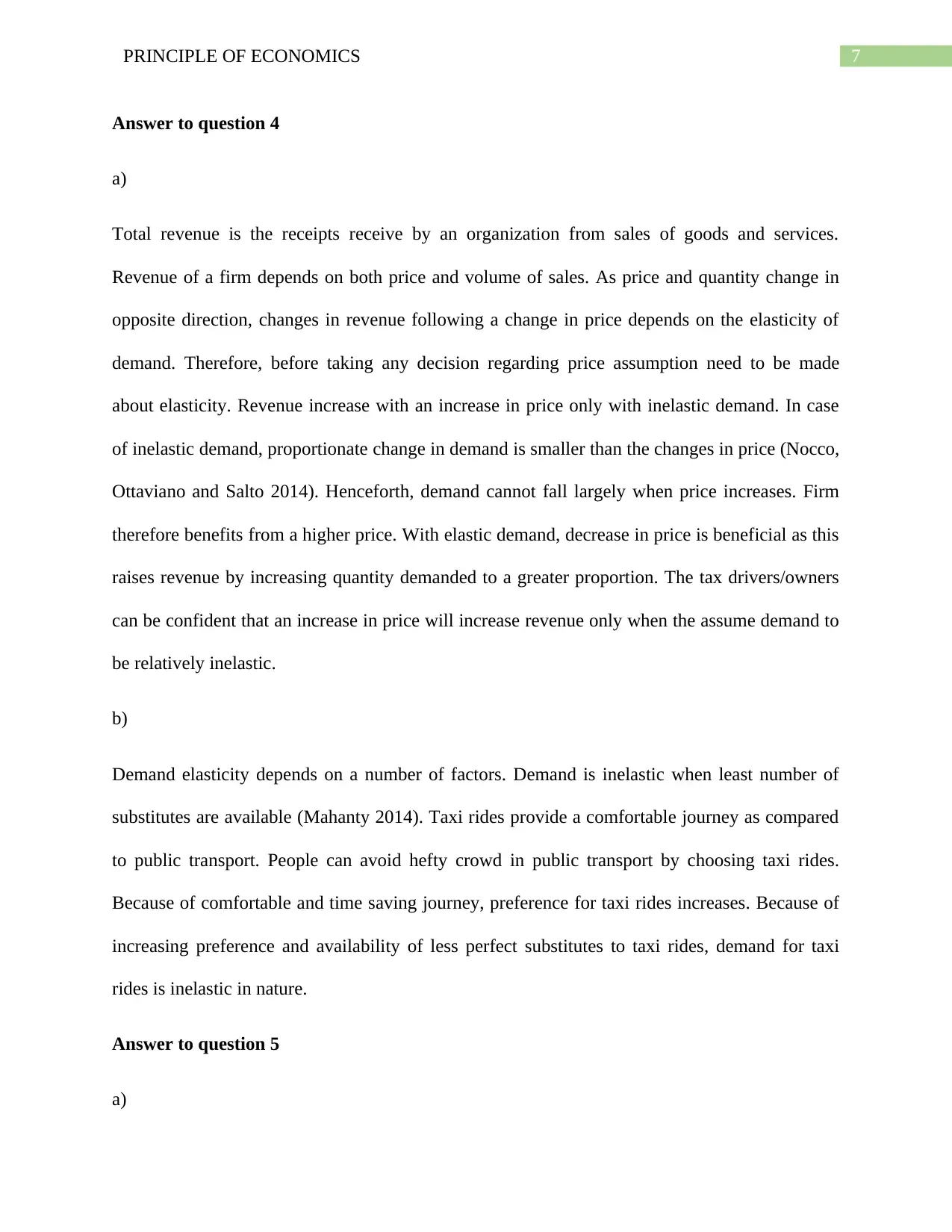
7PRINCIPLE OF ECONOMICS
Answer to question 4
a)
Total revenue is the receipts receive by an organization from sales of goods and services.
Revenue of a firm depends on both price and volume of sales. As price and quantity change in
opposite direction, changes in revenue following a change in price depends on the elasticity of
demand. Therefore, before taking any decision regarding price assumption need to be made
about elasticity. Revenue increase with an increase in price only with inelastic demand. In case
of inelastic demand, proportionate change in demand is smaller than the changes in price (Nocco,
Ottaviano and Salto 2014). Henceforth, demand cannot fall largely when price increases. Firm
therefore benefits from a higher price. With elastic demand, decrease in price is beneficial as this
raises revenue by increasing quantity demanded to a greater proportion. The tax drivers/owners
can be confident that an increase in price will increase revenue only when the assume demand to
be relatively inelastic.
b)
Demand elasticity depends on a number of factors. Demand is inelastic when least number of
substitutes are available (Mahanty 2014). Taxi rides provide a comfortable journey as compared
to public transport. People can avoid hefty crowd in public transport by choosing taxi rides.
Because of comfortable and time saving journey, preference for taxi rides increases. Because of
increasing preference and availability of less perfect substitutes to taxi rides, demand for taxi
rides is inelastic in nature.
Answer to question 5
a)
Answer to question 4
a)
Total revenue is the receipts receive by an organization from sales of goods and services.
Revenue of a firm depends on both price and volume of sales. As price and quantity change in
opposite direction, changes in revenue following a change in price depends on the elasticity of
demand. Therefore, before taking any decision regarding price assumption need to be made
about elasticity. Revenue increase with an increase in price only with inelastic demand. In case
of inelastic demand, proportionate change in demand is smaller than the changes in price (Nocco,
Ottaviano and Salto 2014). Henceforth, demand cannot fall largely when price increases. Firm
therefore benefits from a higher price. With elastic demand, decrease in price is beneficial as this
raises revenue by increasing quantity demanded to a greater proportion. The tax drivers/owners
can be confident that an increase in price will increase revenue only when the assume demand to
be relatively inelastic.
b)
Demand elasticity depends on a number of factors. Demand is inelastic when least number of
substitutes are available (Mahanty 2014). Taxi rides provide a comfortable journey as compared
to public transport. People can avoid hefty crowd in public transport by choosing taxi rides.
Because of comfortable and time saving journey, preference for taxi rides increases. Because of
increasing preference and availability of less perfect substitutes to taxi rides, demand for taxi
rides is inelastic in nature.
Answer to question 5
a)
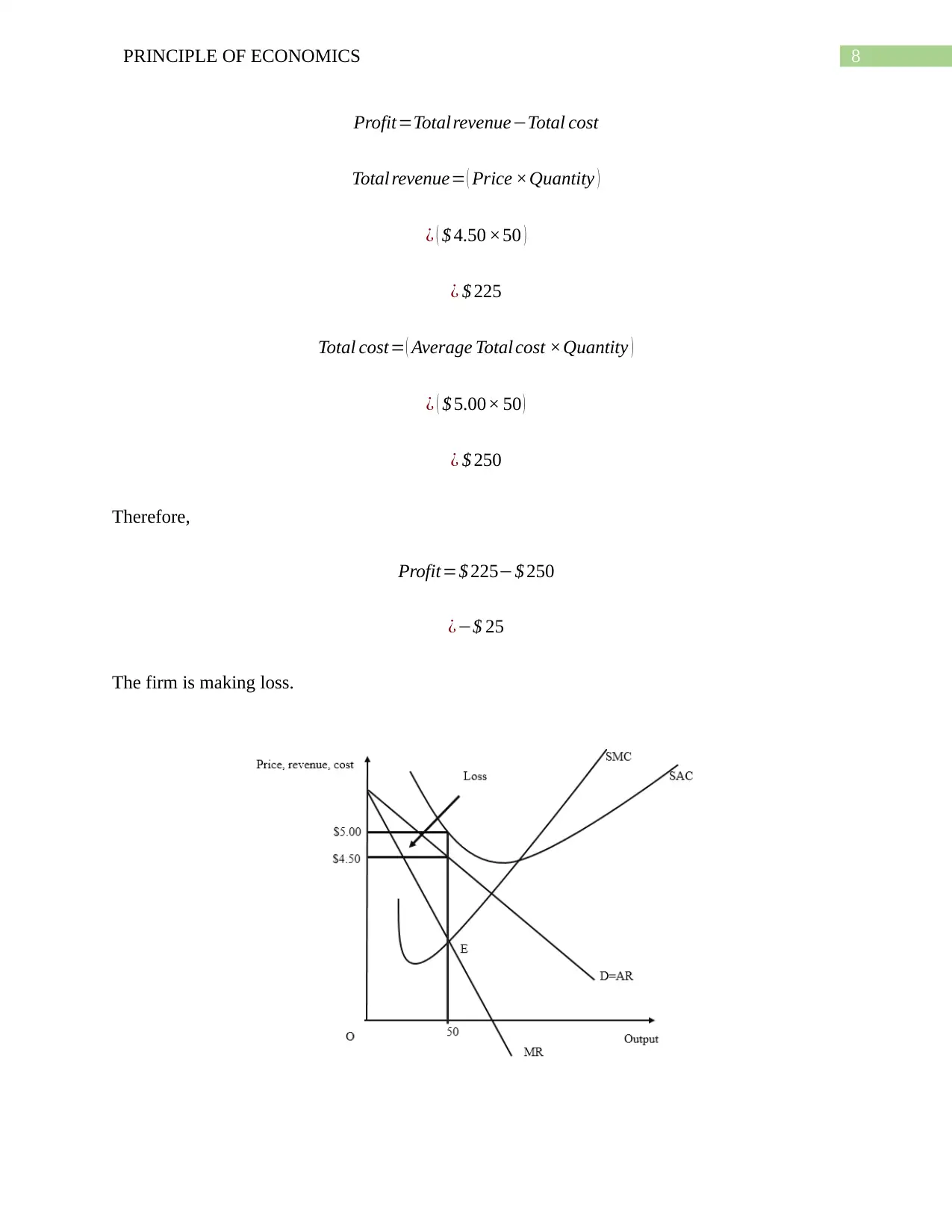
8PRINCIPLE OF ECONOMICS
Profit=Total revenue−Total cost
Total revenue= ( Price ×Quantity )
¿ ( $ 4.50 ×50 )
¿ $ 225
Total cost= ( Average Total cost ×Quantity )
¿ ( $ 5.00× 50 )
¿ $ 250
Therefore,
Profit=$ 225−$ 250
¿−$ 25
The firm is making loss.
Profit=Total revenue−Total cost
Total revenue= ( Price ×Quantity )
¿ ( $ 4.50 ×50 )
¿ $ 225
Total cost= ( Average Total cost ×Quantity )
¿ ( $ 5.00× 50 )
¿ $ 250
Therefore,
Profit=$ 225−$ 250
¿−$ 25
The firm is making loss.
⊘ This is a preview!⊘
Do you want full access?
Subscribe today to unlock all pages.

Trusted by 1+ million students worldwide
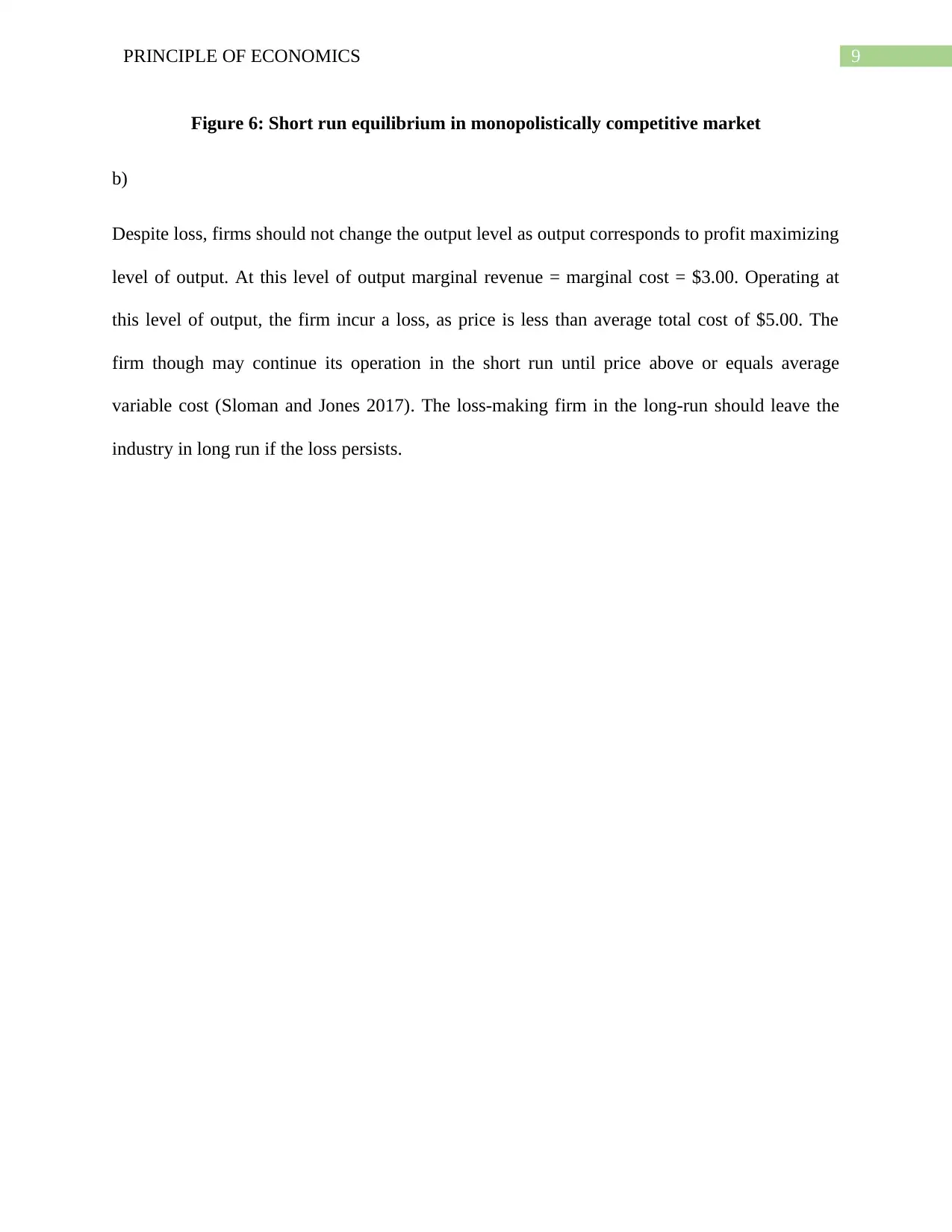
9PRINCIPLE OF ECONOMICS
Figure 6: Short run equilibrium in monopolistically competitive market
b)
Despite loss, firms should not change the output level as output corresponds to profit maximizing
level of output. At this level of output marginal revenue = marginal cost = $3.00. Operating at
this level of output, the firm incur a loss, as price is less than average total cost of $5.00. The
firm though may continue its operation in the short run until price above or equals average
variable cost (Sloman and Jones 2017). The loss-making firm in the long-run should leave the
industry in long run if the loss persists.
Figure 6: Short run equilibrium in monopolistically competitive market
b)
Despite loss, firms should not change the output level as output corresponds to profit maximizing
level of output. At this level of output marginal revenue = marginal cost = $3.00. Operating at
this level of output, the firm incur a loss, as price is less than average total cost of $5.00. The
firm though may continue its operation in the short run until price above or equals average
variable cost (Sloman and Jones 2017). The loss-making firm in the long-run should leave the
industry in long run if the loss persists.
Paraphrase This Document
Need a fresh take? Get an instant paraphrase of this document with our AI Paraphraser
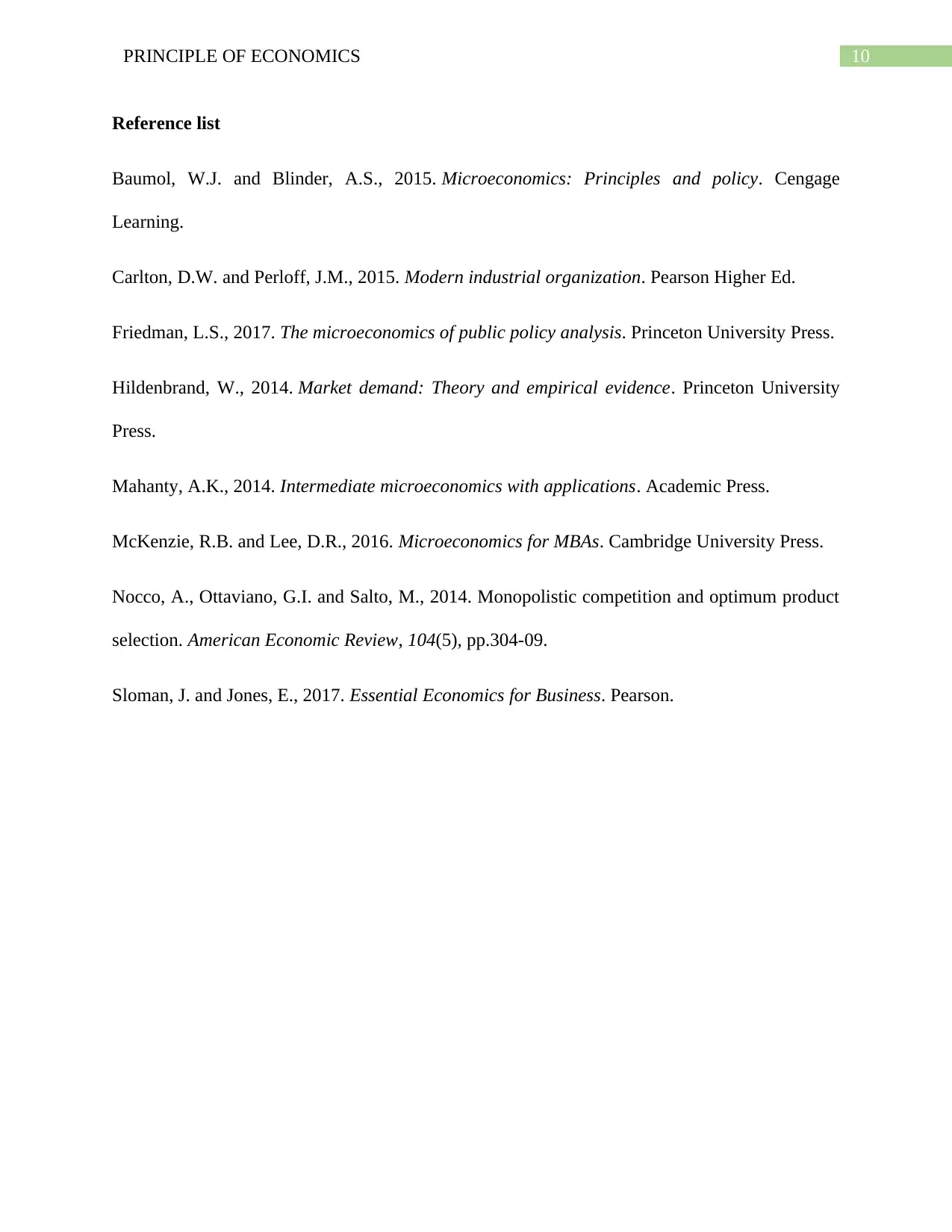
10PRINCIPLE OF ECONOMICS
Reference list
Baumol, W.J. and Blinder, A.S., 2015. Microeconomics: Principles and policy. Cengage
Learning.
Carlton, D.W. and Perloff, J.M., 2015. Modern industrial organization. Pearson Higher Ed.
Friedman, L.S., 2017. The microeconomics of public policy analysis. Princeton University Press.
Hildenbrand, W., 2014. Market demand: Theory and empirical evidence. Princeton University
Press.
Mahanty, A.K., 2014. Intermediate microeconomics with applications. Academic Press.
McKenzie, R.B. and Lee, D.R., 2016. Microeconomics for MBAs. Cambridge University Press.
Nocco, A., Ottaviano, G.I. and Salto, M., 2014. Monopolistic competition and optimum product
selection. American Economic Review, 104(5), pp.304-09.
Sloman, J. and Jones, E., 2017. Essential Economics for Business. Pearson.
Reference list
Baumol, W.J. and Blinder, A.S., 2015. Microeconomics: Principles and policy. Cengage
Learning.
Carlton, D.W. and Perloff, J.M., 2015. Modern industrial organization. Pearson Higher Ed.
Friedman, L.S., 2017. The microeconomics of public policy analysis. Princeton University Press.
Hildenbrand, W., 2014. Market demand: Theory and empirical evidence. Princeton University
Press.
Mahanty, A.K., 2014. Intermediate microeconomics with applications. Academic Press.
McKenzie, R.B. and Lee, D.R., 2016. Microeconomics for MBAs. Cambridge University Press.
Nocco, A., Ottaviano, G.I. and Salto, M., 2014. Monopolistic competition and optimum product
selection. American Economic Review, 104(5), pp.304-09.
Sloman, J. and Jones, E., 2017. Essential Economics for Business. Pearson.
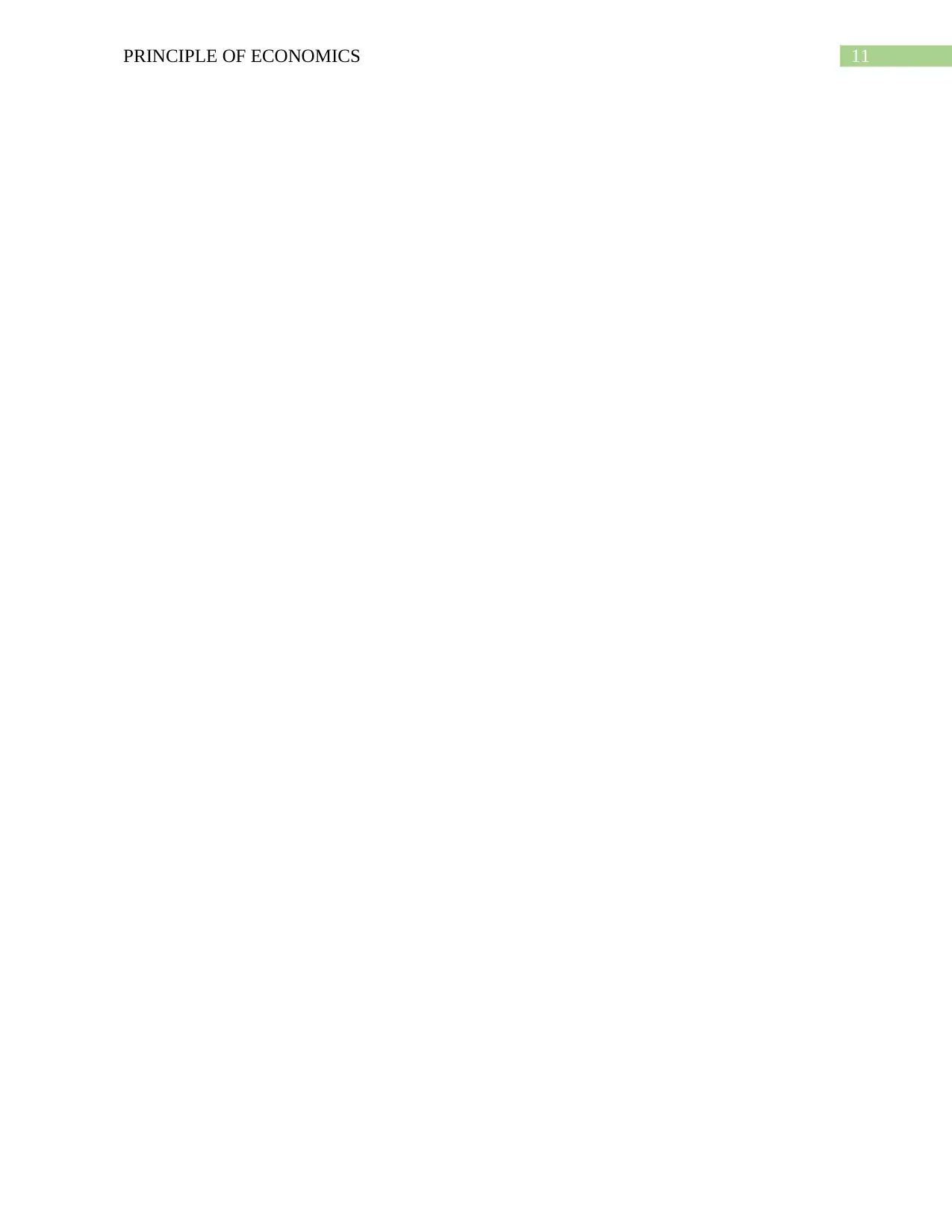
11PRINCIPLE OF ECONOMICS
⊘ This is a preview!⊘
Do you want full access?
Subscribe today to unlock all pages.

Trusted by 1+ million students worldwide
1 out of 12
Related Documents
Your All-in-One AI-Powered Toolkit for Academic Success.
+13062052269
info@desklib.com
Available 24*7 on WhatsApp / Email
![[object Object]](/_next/static/media/star-bottom.7253800d.svg)
Unlock your academic potential
Copyright © 2020–2025 A2Z Services. All Rights Reserved. Developed and managed by ZUCOL.


